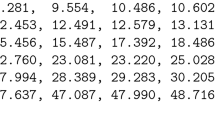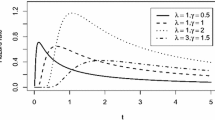Abstract
In this paper we address the problems of estimation and prediction when lifetime data following Burr type III distribution are observed under progressive type-I hybrid censoring. We first obtain maximum likelihood estimators of unknown parameters using expectation maximization and stochastic expectation maximization algorithms, and associated interval estimates using Fisher information matrix. We then obtain Bayes estimators based on non-informative and informative priors under squared error, entropy and Linex loss functions using the method of Tierney–Kadane and importance sampling technique, and associated highest posterior density interval estimates by making use of Chen and Shao method. We further predict the censored observations and interval estimates under classical and Bayesian approaches. Finally we analyze two real data sets, and conduct a simulation study to compare the performance of various proposed estimators and predictors.
Similar content being viewed by others
References
Alkasasbeh MR, Raqab MZ (2009) Estimation of the generalized logistic distribution parameters: comparative study. Stat Methodol 6(3):262–279
Asgharzade A, Abdi M (2008) Point and interval estimation for the burr type iii distribution. J Iran Stat Soc 5:221–233
Arabi Belaghi R, Asl MN, Singh S (2017) On estimating the parameters of the Burr XII model under progressive type-I interval censoring. J Stat Comput Simul 87(16):3132–3151
Balakrishnan N, Cramer E (2014) The art of progressive censoring. Springer, Berlin
Bergander T, Luo Y, Hamza AB (2007) Software defects prediction using operating characteristic curves. In: IEEE international conference on information reuse and integration. pp 713–718
Bouguila N, Wang JH, Hamza AB (2010) Software modules categorization through likelihood and bayesian analysis of finite dirichlet mixtures. J Appl Stat 37(2):235–252
Burr IW (1942) Cumulative frequency functions. Ann Math Stat 13(2):215–232
Chen MH, Shao QM (1999) Monte carlo estimation of bayesian credible and hpd intervals. J Comput Gr Stat 8(1):69–92
Cohen AC (1963) Progressively censored samples in life testing. Technometrics 5(3):327–339
Cramer E, Balakrishnan N (2013) On some exact distributional results based on type-i progressively hybrid censored data from exponential distributions. Stat Methodol 10(1):128–150
Cramer E, Iliopoulos G (2010) Adaptive progressive type-II censoring. Test 19(2):342–358
Dempster AP, Laird NM, Rubin DB (1977) Maximum likelihood from incomplete data via the em algorithm. J R Stat Soc Ser B (Methodol) 39:1–38
Dey S, Singh S, Tripathi YM, Asgharzadeh A (2016) Estimation and prediction for a progressively censored generalized inverted exponential distribution. Stat Methodol 32:185–202
Diebolt J, Celeux G (1993) Asymptotic properties of a stochastic em algorithm for estimating mixing proportions. Stoch Models 9(4):599–613
Epstein B (1954) Truncated life tests in the exponential case. Ann Math Stat 25(3):555–564
Golparvar L, Parsian A (2016) Inference on proportional hazard rate model parameter under type-i progressively hybrid censoring scheme. Commun Stat Theory Methods 45:7258–7274
Kundu D, Joarder A (2006) Analysis of type-ii progressively hybrid censored data. Comput Stat Data Anal 50(10):2509–2528
Lindley DV (1980) Approximate bayesian methods. Trabajos de estadística y de investigación operativa 31(1):223–245
Louis TA (1982) Finding the observed information matrix when using the EM algorithm. J R Stat Soc Ser B (Methodol) 44:226–233
Miller RG Jr (2011) Survival analysis, vol 66. Wiley, Hoboken
Mokhlis NA (2005) Reliability of a stress-strength model with burr type iii distributions. Commun Stat Theory Methods 34(7):1643–1657
Noori Asl M, Belaghi RA, Bevrani H (2016) On Burr XII distribution analysis under progressive type-ii hybrid censored data. Methodol Comput Appl Prob 19(2):665–683
Pant MD, Headrick TC (2015) A characterization of the Burr type III and type XII distributions through the method of percentiles and the spearman correlation. Commun Stat Simul Comput 46:1611–1627
Raqab M, Nagaraja H (1995) On some predictors of future order statistics. Metron 53(1–2):185–204
Sen T, Singh S, Tripathi YM (2019) Statistical inference for Lognormal distribution with type-I progressive hybrid censored data. Am J Math Manag Sci 38(1):70–95
Singh S, Tripathi YM, Wu SJ (2015) On estimating parameters of a progressively censored lognormal distribution. J Stat Comput Simul 85(6):1071–1089
Singh S, Tripathi YM (2015) Reliability sampling plans for a lognormal distribution under progressive first-failure censoring with cost constraint. Stat Pap 56(3):773–817
Singh S, Tripathi YM (2016) Bayesian estimation and prediction for a hybrid censored lognormal distribution. IEEE Trans Reliab 65(2):782–795
Singh S, Tripathi YM (2018) Estimating the parameters of an inverse Weibull distribution under progressive type-I interval censoring. Stat Pap 59(1):21–56
Tierney L, Kadane JB (1986) Accurate approximations for posterior moments and marginal densities. J Am Stat Assoc 81(393):82–86
Tomer SK, Panwar M (2015) Estimation procedures for maxwell distribution under type-I progressive hybrid censoring scheme. J Stat Comput Simul 85(2):339–356
Tregouet D, Escolano S, Tiret L, Mallet A, Golmard J (2004) A new algorithm for haplotype-based association analysis: the stochastic-em algorithm. Ann Hum Genet 68(2):165–177
Wang FK, Cheng Y (2010) EM algorithm for estimating the Burr XII parameters with multiple censored data. Qual Reliab Eng Int 26(6):615–630
Wang FK, Lee CW (2010) An m-estimator for estimating the extended burr type iii parameters with outliers. Commun Stat Theory Methods 40(2):304–322
Wei GC, Tanner MA (1990) A monte carlo implementation of the em algorithm and the poor man’s data augmentation algorithms. J Am Stat Assoc 85(411):699–704
Zhang M, Ye Z, Xie M (2014) A stochastic em algorithm for progressively censored data analysis. Qual Reliab Eng Int 30(5):711–722
Acknowledgements
Authors thank the Editor and the Associate Editor for their suggestions. We are very grateful to four anonymous referees for carefully going through our manuscript, and their constructive comments have led significant improvements in the earlier version of this manuscript.
Author information
Authors and Affiliations
Corresponding author
Additional information
Publisher's Note
Springer Nature remains neutral with regard to jurisdictional claims in published maps and institutional affiliations.
Appendix
Appendix
Rights and permissions
About this article
Cite this article
Singh, S., Arabi Belaghi, R. & Noori Asl, M. Estimation and prediction using classical and Bayesian approaches for Burr III model under progressive type-I hybrid censoring. Int J Syst Assur Eng Manag 10, 746–764 (2019). https://doi.org/10.1007/s13198-019-00806-9
Received:
Revised:
Published:
Issue Date:
DOI: https://doi.org/10.1007/s13198-019-00806-9




